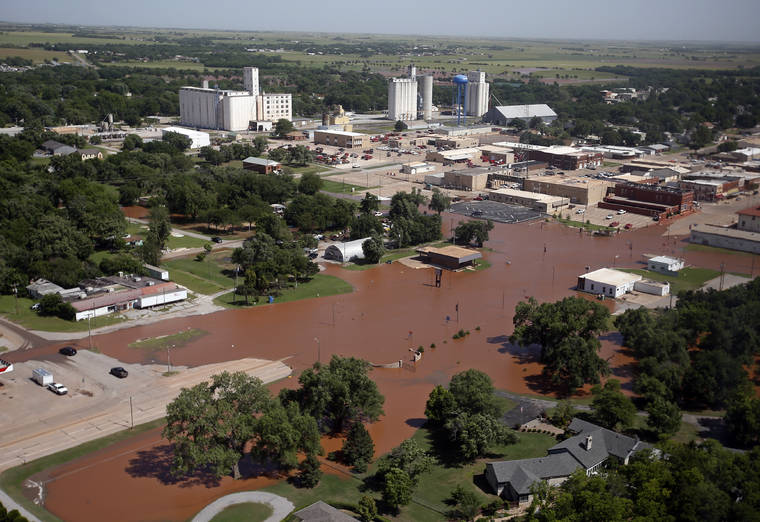OKLAHOMA CITY — Waterlogged parts of the central U.S. were bracing Wednesday for more rain, following days of severe storms that have battered Iowa, Kansas, Missouri and Oklahoma and caused at least three deaths.
Residents of some small towns in Oklahoma and Kansas were being urged to leave their homes as rivers and streams rose. The Arkansas River is approaching historic highs, while the already high Missouri and Mississippi Rivers were again rising after a multi-day stretch of storms that produced dozens of tornadoes. Forecasters say parts of Oklahoma, Missouri and Kansas could see more severe weather Wednesday night into Thursday.
“The biggest concern is more rain,” Oklahoma Gov. Kevin Stitt said during a news conference following an aerial tour with Tulsa Mayor G.W. Bynum and other officials Wednesday morning.
Officials were encouraging residents in the Tulsa suburb of Sand Springs; in Fort Gibson, about 50 miles (80 kilometers) southwest of Tulsa; and in Webbers Falls, some 70 miles (113 kilometers) southeast of Tulsa, to leave. All three communities are along the Arkansas River.
Near Crescent, about 34 miles (55 kilometers) north of Oklahoma City, erosion left several homes hanging over the swollen Cimarron River. One unoccupied home rolled into the river Tuesday, and authorities say others could collapse.
In Kansas, residents in parts of the city of Iola, along the Neosho River, were being urged to evacuate and officials had set up on emergency shelter at a community college, said Corey Schinstock, assistant city administrator. If the river reaches its predicted crest of 27.8 feet (8.47 meters) Thursday, it would be the second-worst flood ever for the town of about 5,400 residents.
The National Weather Service issued flood warnings for northeastern Oklahoma through the weekend and in southeastern Kansas and southwestern Missouri through Thursday afternoon.
The deluge inundated roadways, closing highways in 22 Oklahoma counties and 17 Kansas counties, along with more than 330 Missouri roads. Amtrak suspended train service Wednesday and Thursday along a route between St. Louis and Kansas City because of congestion and flood-related delays.
More than 9 inches (23 centimeters) of rain has fallen since Sunday in parts of Oklahoma after an already rainy spring.
“Any rainfall we get just continues to saturate the soils that are already saturated. Especially rivers and streams,” said Oklahoma State Climatologist Gary McManus.
“There is simply nowhere for this water to go” as it flows downstream from Kansas, according to McManus.
The Arkansas River was at 37 feet (11 meters), or 9 feet (2.74 meters) above flood stage, at Muskogee, 45 miles (72 kilometers) southeast of Tulsa, as of late Wednesday morning, according to the National Weather Service. The river was expected to rise to 40 feet (12 meters) by Thursday morning, eventually reaching 41 feet (12.5).
Bynum, Tulsa’s mayor, said his city of more than 400,000 people is safe so far.
“The levee system is working the way it’s supposed to right now,” Bynum said.
Elsewhere, the Mississippi River was at or approaching major flood stage from Iowa through southern Missouri and Illinois. At St. Louis, the Mississippi was expected to crest Monday at nearly 12 feet (3.7 meters) above flood stage. If that holds, the Coast Guard will likely close the river to navigation for the second time this month.
The Missouri River was expected to crest Thursday at 36.1 feet (11 meters) near the town of Glasgow, Missouri, overtopping agricultural levees and inundating some homes, highways and parkland.
Deaths from this week’s storms include a 74-year-old woman found early Wednesday morning in Iowa. Officials there say she was killed by a possible tornado that damaged a farmstead in Adair County. Missouri authorities said heavy rain was a contributing factor in the deaths of two people in a traffic accident Tuesday near Springfield.
A fourth weather-related death may have occurred in Oklahoma, where the Highway Patrol said a woman apparently drowned after driving around a barricade Tuesday near Perkins, about 45 miles (72 kilometers) northeast of Oklahoma City. The unidentified woman’s body was sent to the state medical examiner’s office to confirm the cause of death. Oklahoma Department of Emergency Management spokeswoman Keli Cain said she isn’t yet listed as what would be the state’s first storm-related death.
———
Associated Press writers Jill Bleed in Little Rock, Arkansas; Tim Talley in Oklahoma City; Jim Salter in St. Louis; and Heather Hollingsworth in Kansas City, Missouri, contributed to this report.





